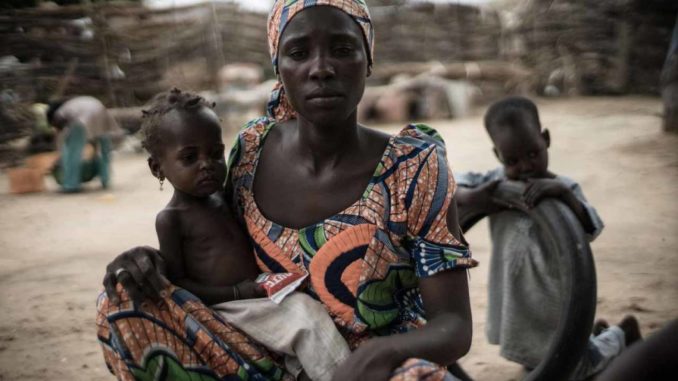
HUNGER is ravaging the land. Worse, there is no end in sight as the latest forecast by the Food and Agriculture Organisation strongly projects that Nigeria’s efforts to achieve zero hunger by 2030 are being seriously undermined. At the 2018 World Food Day, the Rome-based agency warned of the dangers ahead, citing climate change and the ethno-religious conflicts plaguing the country. The federal and state governments ought to heed the warning and implement solutions to the impending spectre of food shortage.
Already, signs of the food deficit are visible. The United Nations, the African Development Bank and the British Prime Minister, Theresa May, have described Nigeria as the global poverty capital. May and the AfDB aver that 80 per cent of the population are living in extreme poverty. An FAO report added that 2.3 million people in Adamawa, Borno and Yobe, the three states hardest hit by the Boko Haram insurgency, faced acute food shortages. In all, it said 13 million Nigerians suffered from hunger as of 2016.
It is not that Nigeria cannot feed its citizens, but because of poor coordination, reliance on oil income and misplacement of priorities, all efforts fall flat. This is why the FAO lists Nigeria as “one of the 37 countries in the world in need of external food assistance.” Here, agriculture is characterised by low output, low technology and is labour intensive. Subsistence farmers in the rural areas employ outdated methods. The National Agricultural Seed Council says farmers lack certified seeds, which are critical in ensuring good yield.
The 2017 National Report issued by the Federal Department of Agriculture and Extension Services underlines this. For instance, sorghum farmers produced 6.7 million metric tonnes (or an average of 1.19 tonnes per hectare) from 5.6 million hectares of land. Millet was worse, producing 0.08 tonnes per hectare. These crops yield between four to seven tonnes per hectare in Kenya, South Africa and Zimbabwe.
Similarly, farmers lack safe water for irrigation and sanitation. Because of woeful rural roads and high cost of transportation, harvests rot on the farms before getting to the city. Storage and added-value are rudimentary. This makes yam, tomato, pepper, cassava, fruits and vegetables expensive. Thus, farmers miss revenue and the people go hungry.
The drive by the government to mitigate the food deficit is being jeopardised by nature. Uncontrollable flooding has destroyed crops in the food-producing states. In Edo State, flooding swept away 280 hectares of rice plantation in Ovia last August. The rampaging flood has wreaked havoc on farms in Adamawa, Kogi, Benue, Kebbi, Niger, Delta and Bayelsa this year. In 2017, the authorities said 10,000 small-holding farmers had their crops washed away by flood after seven days of torrential rain in Benue State.
Concurrently, the Boko Haram conflict is driving away farmers from their homes in North-East Nigeria. President Muhammadu Buhari stated in 2016 that over two million people were in internally displaced persons camps. The North-Central, which includes Benue and Plateau states, suffers gravely from cyclical Fulani herdsmen attacks. The effect of the attacks on food production is damaging.
All this leaves Nigeria in a desperate situation. Awash with oil dollars, Nigeria has been taking the easy way out with food imports. Top of the list are rice, fruits, frozen poultry, and palm oil, where the country has comparative advantage. The Minister of State for Agriculture, Heineken Lokpobiri, stated that Nigeria imported food annually with $22 billion. With the economy comatose, this is neither sustainable nor wise.
Therefore, local remedies are imperative in reversing the deficit. Among them is an integrated transport system that will enable harvests to reach their intended destinations on time. Under the Pradhan Mantri Gram Sadak Yojana flagship scheme commissioned in 2011 by India, that country’s Rural Development Ministry targeted the construction of 67,000 kilometres of rural roads in the first phase. With green technologies such as the use of waste plastic, fly-ash, cold mix, jute and coir geo-textiles, it constructed 75km of rural roads daily between 2011 and 2015; in the 2016-17 year, construction was upgraded to 139km per day. Therefore, we need a clear road map on rural roads. With the economy looking to rebound, the Muhammadu Buhari administration should open up the rail sector to international investors. Simultaneously, this brings in foreign direct investment and aids the movement of produce and goods.
There is the need to provide quality seed. This comes through research. For now, the universities of agriculture, the research institutes and colleges of agriculture are not effective in this area. They should be revived. Government should guarantee low-priced loans – just as it did successfully with the Anchor Borrower’s Programme for rice – in all aspects of agriculture to encourage farmers in doubling capacity.
Furthermore, the insecurity ravaging the country demands a fresh impetus, for without curbing the Boko Haram insurgency and the Fulani herdsmen menace, it is near impossible for farming to flourish. Government should encourage ranching and deal decisively with the insurgents, and encourage the use of technology to process farm produce. It should step up international collaboration to restore Lake Chad, which used to support 2.6 million farmers, livestock rearers and fishermen, according to the FAO.
END

Be the first to comment